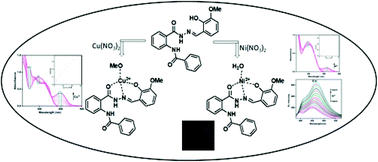A dual-mode highly selective and sensitive Schiff base chemosensor for fluorescent colorimetric detection of Ni2+ and colorimetric detection of Cu2+†
Abstract
In this paper, a novel flexible Schiff base chemosensor N′-(2-hydroxy-3-methoxybenzylidene)-2-(benzamido)benzohydrazide (L) has been designed, synthesised and characterised by 1H-NMR, IR spectroscopy, ESI-MS spectrometry and single crystal XRD analysis. A significant fluorescence enhancement of L was observed only in the presence of Ni2+ ions with a detection limit of 3.64 μM whereas Cu2+ induced fluorescence quenching, although both the metals showed colorimetric responses in methanol–Tris-HCl buffer (10 mM, pH 7.2) solution (1 : 1, v/v). The single crystal structure of L–Cu2+ has also been determined. No major interference by the other effective background cations (Fe3+, Fe2+, Co2+, Zn2+, Cd2+, Hg2+, Pb2+, Cr3+, Ag+, Al3+ and Mn2+) was observed even at a higher concentration of analytes. The experimental results were further supported by DFT studies. The chemosensor L can be applied to the formation of binary logical devices, recovery of contaminated water samples and living intracellular media.



 Please wait while we load your content...
Please wait while we load your content...